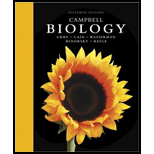
Concept explainers
To determine: The reason how an enzyme cofactor needed for an essential process is an essential nutrient for only some animals.
Introduction: A coenzyme is an organic non-protein compound that binds with an enzyme to catalyze a reaction. Many coenzymes, though not all, are vitamins or derived from vitamins. Thus, the enzyme cofactors play an important role in performing normal physiological processes in their system. Most of the animals can synthesize these enzyme cofactors in their own body, but some require their supply through diet.
Explanation of Solution
Essential nutrients are the nutrients that cannot be synthesized by the body but required to carry out the normal physiological functions and must be provided through diet. There are six essential nutrients: carbohydrates, fats, proteins, vitamins, minerals, and water. Coenzymes primarily function as helper molecules in enzyme-catalyzed reactions. Most of the coenzymes are the vitamins (Vitamins A, C, B1, B2, B3, B6, B12, H, and K) or vitamin derivatives (NADH, FADH, Quinine, and CoA).
Many animals can produce most of the vitamins they need such as vitamin B3, vitamin C, and vitamin D on their own. But some of the animals cannot synthesize some vitamins or vitamin-derived cofactors, which are thus essential nutrients for them, and they need to intake these in their diet.
- For example, anthropoid primates (humans, monkeys, and apes), guinea pigs, particular Indian fruit-eating bat, and some birds do not possess the ability to synthesize Vitamin C because of a defective mutation in the gene controlling the synthesis of L-gulonolactone oxidase (GLO gene) that blocks the conversion of glucose to ascorbic acid.
- The common ancestor of birds and mammals today live in an environment with abundance of green plants containing thiamine. Hence, they lost the gene responsible for the production of Vitamin B1 (thiamine) in their own body. Thus, Vitamin B1 became an essential nutrient for them.
The cofactors are needed as an essential nutrient in some animals that lack the ability to produce enzyme cofactors in their own body.
Want to see more full solutions like this?
Chapter 41 Solutions
CAMPBELL BIOLOGY-W/MOD.MASTERBIOLOGY
- What is the structure and function of Eukaryotic cells, including their organelles? How are Eukaryotic cells different than Prokaryotic cells, in terms of evolution which form of the cell might have came first? How do Eukaryotic cells become malignant (cancerous)?arrow_forwardWhat are the roles of DNA and proteins inside of the cell? What are the building blocks or molecular components of the DNA and proteins? How are proteins produced within the cell? What connection is there between DNA, proteins, and the cell cycle? What is the relationship between DNA, proteins, and Cancer?arrow_forwardWhy cells go through various types of cell division and how eukaryotic cells control cell growth through the cell cycle control system?arrow_forward
- In one paragraph show how atoms and they're structure are related to the structure of dna and proteins. Talk about what atoms are. what they're made of, why chemical bonding is important to DNA?arrow_forwardWhat are the structure and properties of atoms and chemical bonds (especially how they relate to DNA and proteins).arrow_forwardThe Sentinel Cell: Nature’s Answer to Cancer?arrow_forward
- Molecular Biology Question You are working to characterize a novel protein in mice. Analysis shows that high levels of the primary transcript that codes for this protein are found in tissue from the brain, muscle, liver, and pancreas. However, an antibody that recognizes the C-terminal portion of the protein indicates that the protein is present in brain, muscle, and liver, but not in the pancreas. What is the most likely explanation for this result?arrow_forwardMolecular Biology Explain/discuss how “slow stop” and “quick/fast stop” mutants wereused to identify different protein involved in DNA replication in E. coli.arrow_forwardMolecular Biology Question A gene that codes for a protein was removed from a eukaryotic cell and inserted into a prokaryotic cell. Although the gene was successfully transcribed and translated, it produced a different protein than it produced in the eukaryotic cell. What is the most likely explanation?arrow_forward
 Human Physiology: From Cells to Systems (MindTap ...BiologyISBN:9781285866932Author:Lauralee SherwoodPublisher:Cengage Learning
Human Physiology: From Cells to Systems (MindTap ...BiologyISBN:9781285866932Author:Lauralee SherwoodPublisher:Cengage Learning Biology Today and Tomorrow without Physiology (Mi...BiologyISBN:9781305117396Author:Cecie Starr, Christine Evers, Lisa StarrPublisher:Cengage Learning
Biology Today and Tomorrow without Physiology (Mi...BiologyISBN:9781305117396Author:Cecie Starr, Christine Evers, Lisa StarrPublisher:Cengage Learning BiochemistryBiochemistryISBN:9781305577206Author:Reginald H. Garrett, Charles M. GrishamPublisher:Cengage Learning
BiochemistryBiochemistryISBN:9781305577206Author:Reginald H. Garrett, Charles M. GrishamPublisher:Cengage Learning Biology (MindTap Course List)BiologyISBN:9781337392938Author:Eldra Solomon, Charles Martin, Diana W. Martin, Linda R. BergPublisher:Cengage Learning
Biology (MindTap Course List)BiologyISBN:9781337392938Author:Eldra Solomon, Charles Martin, Diana W. Martin, Linda R. BergPublisher:Cengage Learning
 Biology: The Dynamic Science (MindTap Course List)BiologyISBN:9781305389892Author:Peter J. Russell, Paul E. Hertz, Beverly McMillanPublisher:Cengage Learning
Biology: The Dynamic Science (MindTap Course List)BiologyISBN:9781305389892Author:Peter J. Russell, Paul E. Hertz, Beverly McMillanPublisher:Cengage Learning





